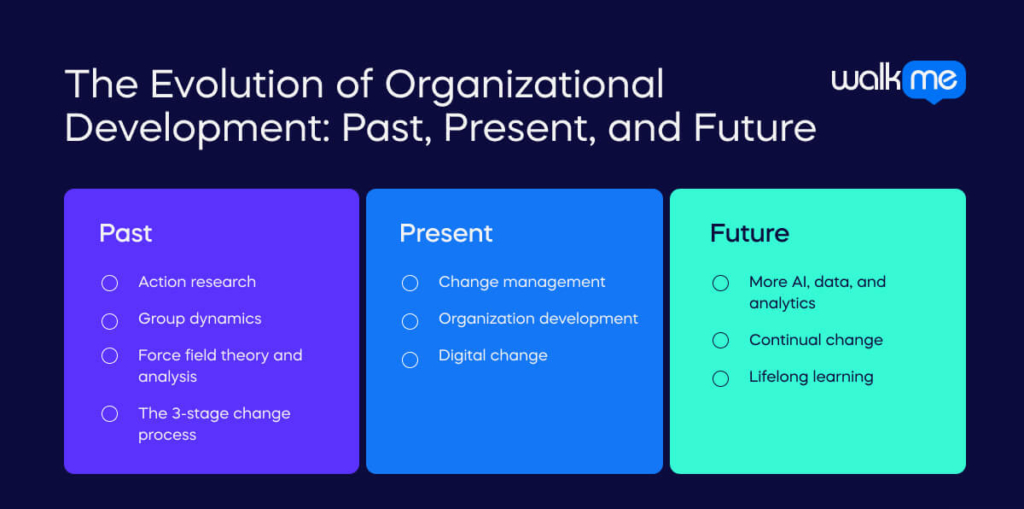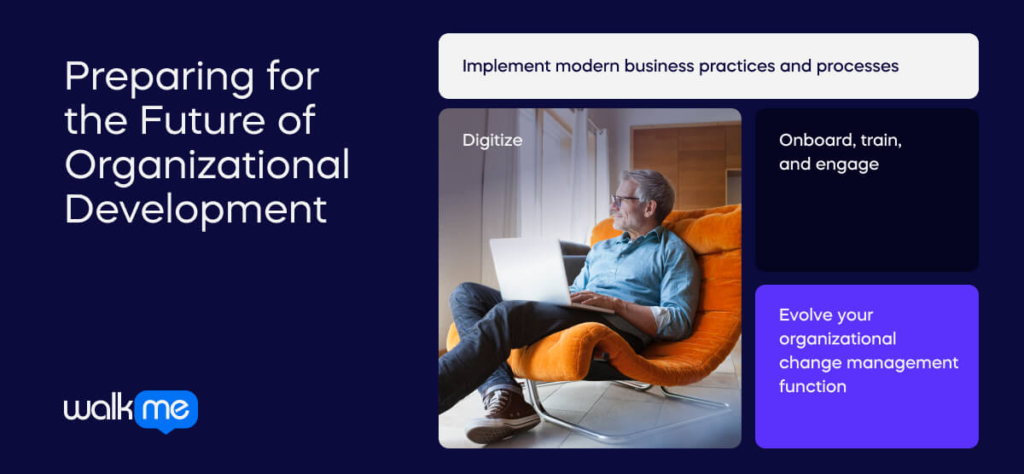We can learn a lot by understanding the evolution of organizational development.
In this article, we’ll learn more about that history, including:
- How the field of organizational change management started
- What change management looks like today
- What to expect from the future of strategic organizational development
For anyone seriously interested in change management, understanding the evolution of organizational development can add significant value to your change projects.
The Evolution of Organizational Development: Past, Present, and Future

Let’s start with the beginning of change management and organizational development.
Past
In the early part of the last century, Kurt Lewin developed a body of ideas that became the foundation of change management.
These include:
- Action research is a form of participatory problem-solving. By working together, a group can more effectively analyze, address, and fix problems.
- Group dynamics. Group dynamics refers to how groups behave and interact. This psychological approach helps change managers understand how employees react to change. In turn, this helps managers address employee resistance and other barriers to change.
- Force field theory and analysis. This framework looks at factors that influence a situation – an individual, goals, and forces that either hinder or enable an individual’s movement toward that goal.
- The 3-stage change process. Kurt Lewin’s change model has informed many other subsequent change frameworks. This framework identifies three main stages in any change process – unfreezing previous processes, transitioning to a new state, and refreezing the new status quo.
Throughout the latter half of the 20th century, a number of scholars further developed these ideas.
Those developments led to change management models as they exist today.
Present
What does organizational development look like today?
Here is a snapshot:
- Change management. Change management is the business discipline devoted to managing change, mitigating risk, executing change projects, maximizing project ROI, and so on. Today’s change practitioners use methods developed from the ideas covered above, such as John Kotter’s 8-step change model or Prosci’s ADKAR model.
- Organization development. Organization development (OD), is another field devoted to executing and managing change projects. Many of the foundational ideas are the same and it shares many of the same aims. However, its specific methods and objectives can be distinct from those of change management.
- Digital change. Today, all businesses are becoming digital. And change management is also digitizing, through the use of data, analytics, automation, and other digital tools and processes. To stay relevant and effective, change managers should begin digitizing their own approaches to organizational development.
We are clearly in the midst of a digital revolution – and change management will continue to evolve and change during the coming years.
Future
What does the future hold for the evolution of organizational development?
Here are a few things to look for:
- More AI, data, and analytics. Today’s most cutting-edge change managers implement data, analytics, and AI. These can be used to predict project outcomes, improve team synergy, analyze project performance, and much more.
- Continual change. The digital revolution is far from over. To keep up with an economy in transition, businesses should prepare themselves for continual, ongoing change. In the coming years, expect more technology-driven changes – not less.
- Lifelong learning. Today’s businesses are already facing a digital skills shortage. And in the coming years, the digital skills gap will widen and become a permanent feature of business. To keep employees relevant, effective training will be more important than ever.
Given these trends, how should change managers prepare for the future of organizational development?
Preparing for the Future of Organizational Development

Here are a few ideas:
- Digitize. The digital ecosystem demands digital tools, technology, and techniques. The most effective change managers will be digitally fluent. Change management will always remain human-centered. But effective use of technology will also become a requirement.
- Implement modern business practices and processes. Agile change management, business agility, lean business processes, and other adaptable business approaches get great results. In the future, such modern business practices will likely become the norm.
- Onboard, train, and engage. Since lifelong learning is set to become common, businesses should prioritize training. Well-trained employees will be more skilled, more productive, and more satisfied. To build robust training programs, combine the right tools with effective training solutions – such as digital adoption platforms.
- Evolve your organizational change management function. Poor change management gets poor results. But, as we have seen, the future only holds more change. Effective change management therefore, will become a strategic differentiator.
Final Thoughts
Today, technology is driving many business changes.
It has fueled the development of new business processes, new products, and new ways of thinking.
To stay relevant, change management must utilize digital technology to its fullest extent.
This means digital strategy, digital transformation, and digital adoption.
However, at the same time, the human experience is becoming more important as a revenue driver.
Effective change managers will be able to juggle both of these elements – the human side and the digital side.

